 This work is licensed under a CC BY 4.0 International License
This work is licensed under a CC BY 4.0 International License
Contact
Photos of people in Hamilton’s biography

The Hamilton couple at Broom Bridge:
Hamilton scratches the fundamental quaternion formula on a stone of the bridge © Daniel Doyle. Shown here with permission.
Depicted in 2012 as i
2=j
2=k
2=ijk=-1 by Daniel Doyle, this beautiful sand sculpture of Hamilton's discovery of quaternions on the 16th of October 1843 shows, as was shown in my essay
A Victorian Marriage, a good marriage and an interested wife.
Although for this website this is the most important side of the sculpture, it officially was the back side. On the
front side of the sculpture Hamilton can be seen, “trying to understand the 3-Dimension world which led him to the equation.”
Here is another picture of the back side of the sculpture from a different angle, and
here is a slideshow of the making of the sculpture.
For more photos of Doyle’s sculptures see his
flickr page, for the making of the sculpture see ‘
An ode to science’, by Mark O'Regan, 08 Aug 2012.
The Hamilton Couple
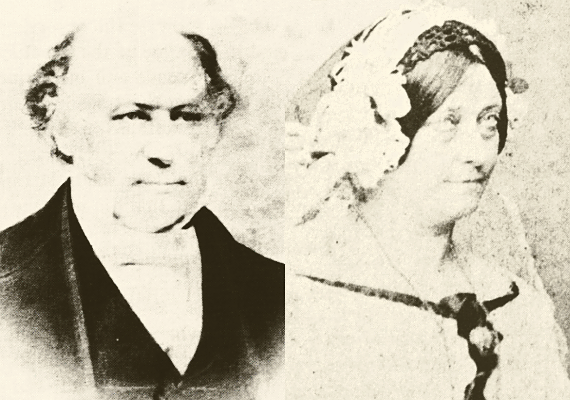
Sir William Rowan Hamilton and Lady Helena Maria Hamilton née Bayly around 1855.
Reproduced from Wayman, P.A. (1987), Dunsink Observatory, 1785-1985 : A Bicentennial History. Dublin: The Royal Dublin Society and The Dublin Institute for Advanced Studies. Hamilton’s photo is slightly damaged, which can be seen at the left side of his face.
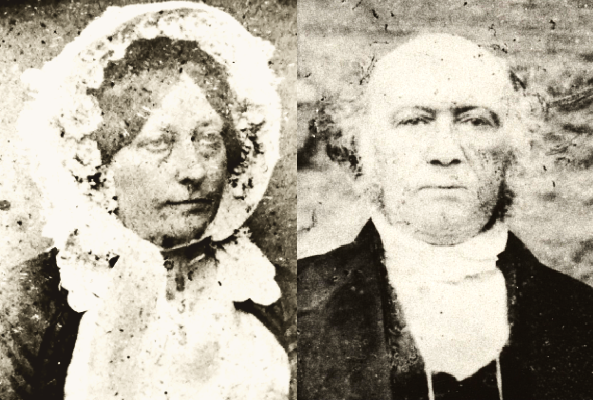
Sir William Rowan Hamilton and Lady Helena Maria Hamilton née Bayly around 1860. Reproduced (and then slightly adapted by removing some blots) from a
tweet from TCD Research Collections, and from a photo of a photo in possession of Trinity College Dublin Library. It is shown here courtesy of the Board of Trinity College Dublin.
Graves described Hamilton as follows: “It may be well here to give the reader such an outline as can be drawn by memory of Hamilton’s personal appearance at this time of his life [1824]. He was of middle height, but his breadth of shoulders and amplitude of chest made him appear shorter than he really was. His head, when in social intercourse, he generally carried with an upward inclination, giving to full view his countenance beaming with an expression of ingenuous cheerfulness and receptivity. His features were not either beautiful or handsome, but there was a certain harmony in their combination which indicated strength, and in these early years produced almost the effect of good looks. His eyes were light blue; his hair was a dark silky chestnut: his nose rather broad below, the distance between it and the mouth being somewhat in excess [...]. The mouth itself of moderate size, with upper lip flexible in speaking, and slightly pouting when at rest; the chin well shaped and firm, while the breadth of the skull at its base, and its equable hemispherical development, betokened at first view a certain intellectual grandeur. He was strong and active on his limbs; his hands were soft and fair; his fingers, as has been noted by his friend Professor De Morgan, broad at the ends, and apparently not adapted for nice manipulations. Yet his manuscript, even when very minute, was exceptionally clear; and the drawing of his mathematical diagrams, which were often of great complexity, was remarkable for neatness and accuracy.”
Nine times Sir William Rowan Hamilton
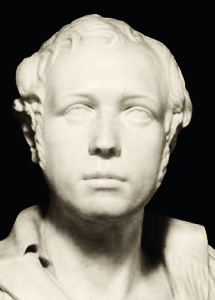
Hamilton in 1830Reproduced from the National Gallery of Ireland, Dublin. The Gallery has
two photos of the bust. Photo © National Gallery of Ireland.
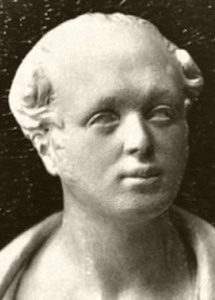
Hamilton in 1833Reproduced from Graves, R.P. (1882),
Life of Sir William Rowan Hamilton, Vol. I. Dublin: Hodges, Figgis, & Co.
archive.org
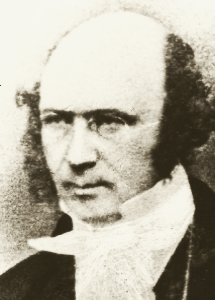
Hamilton ca 1846Reproduced from Ch. Mollan et al., (2002),
Irish Innovators in Science and Technology.
Royal Irish Academy Courtesy Trinity College Dublin.
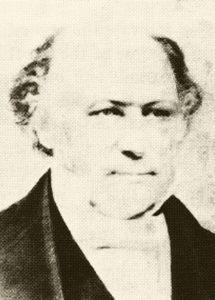
Hamilton ca 1855
Reproduced from Wayman, P.A. (1987), Dunsink Observatory, 1785-1985. Dublin: The Royal Dublin Society and The Dublin Institute for Advanced Studies.

Hamilton as if in his fifties Reproduced from Graves, R.P. (1889),
Life of Sir William Rowan Hamilton, Vol. III. Dublin: Hodges, Figgis, & Co.
archive.org
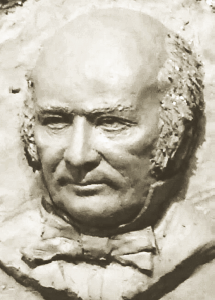
Hamilton as if in his fifties
2019 clay sculpture by Max Power in recognition of endeavours on behalf of WRH. The bust does not exist any more. Courtesy Max Power.

Hamilton in 1859Reproduced from Graves, R.P. (1889),
Life of Sir William Rowan Hamilton, Vol. II. Dublin: Hodges, Figgis, & Co.
archive.org

Hamilton ca 1864
Reproduced from Wayman, P.A. (1987), Dunsink Observatory, 1785-1985. Dublin: The Royal Dublin Society and The Dublin Institute for Advanced Studies.
The first bust shown above was made in 1830 by Thomas Kirk. Graves writes that during a visit to the Dunravens, the parents of his pupil Lord Adare, “Lord Dunraven requested him to sit to Kirk, the Dublin sculptor, for a marble bust. The request was complied with before the end of 1830; and one of Hamilton’s letters intimates the fact that, as part of he preparation for its execution, he had to submit to a cast being taken from his head. The bust may therefore be supposed faithfully to represent his cranial development, and in this respect to possess a permanent value.” Graves then compares the 1830 bust with the 1833 one, “in its representation, however, of the features of the face, it seems to me to be inferior as a likeness to a miniature bust executed in 1833 by Mr. Terence Farrell [...]. I have therefore preferred to prefix as frontispiece to this [first] volume an autotype copy from a cast taken from the model of the latter.” According to a note made by Clement Ingleby, given in his 1867 book Memorabilia and memorials of Sir William Rowan Hamilton : collected in his honour by Clement Mansfield Ingleby, the first bust was in the possession of Lord Dunraven, the second one in that of Lord Talbot de Malahide.
The photo made around 1846 is a part of a part of a daguerreotype. In his book Ingleby gave a comment from William Edwin Hamilton, that the larger portrait, showing ‘Hamilton and one of his sons’, was itself a part of a daguerreotype of Sir William, Lady Helen and their family, made by the artist Glukman. “From this portrait Messrs Nelson and Mayhall took the glass negative, of which it is a print.”* In my AVM I had placed the part showing the son, surmising it was William Edwin, in the third row of the overview of the Hamilton family. The fact that William Edwin did not comment on who the boy in the photo is, underpins the suggestion that it is he, and not Archibald.
* The artists were Leone Glukman, 24 Upper Sackville Street, Dublin, and Nelson & Marshall, at no. 11.
The photo made around 1855 comes from a family album of the O’Regan family, together with the
photo of Lady Hamilton. As stated in the caption, it was given in the book about Dunsink Observatory by Patrick Wayman. (Jan 2023: it was slightly damaged; I tried to restore it a bit.) Of the photo taken around 1860 I do not know anything except that it was used in the online celebration of Schrodinger. I took out some of the blots on his face; for what I did see the comparison.
Graves regarded as the best images of Hamilton the 1859 photograph, which he gave as a frontispiece to the second volume, and the photograph made from the 1867 bust, given as a frontispiece to the third volume and showing Hamilton as he may have looked like in his fifties. About the 1859 portrait Graves wrote, “I take the opportunity of expressing my opinion that this representation of his features stands out from all other photographs of him which I have seen (and I believe I have seen almost all that were taken), as alone doing something like justice to the combined intellectual and moral character of the subject. It exhibits, I think, both in conformation and expression, the profound thinker, the reverent benevolent sage. The marble bust in the Library of Trinity College is from the hand of Foley, and a photograph from it supplies the frontispiece to the present [3rd] volume. Our eminent sculptor never had the advantage of seeing Sir W.R. Hamilton, and had to work from small photographs and a cast of the anterior half of the head. The aspect which the photograph presents will, however, be acknowledged by all who knew the living man to be both fine and like.” [Graves 1889, 120].
Max Power, who in 2019 made the newest addition, the clay bust, used the 1859 photo and the Foley bust, and it is so much like the image of Hamilton I have in my mind that seeing it for the first time it seemed to me as if the Foley bust had turned around to look at something else. But with an even better likeness to the 1859 photo, which is the reason I placed it between those two images.
The last photo was also given by Wayman in his book about Dunsink Observatory, and he remarked in its caption, “The last known photograph of Sir William, taken in 1864 or thereabouts. This photograph, from the records of the O’Regan family, is referred to in an extant letter from Helen Eliza Hamilton, before her marriage, to Ann O’Regan, sister of her future husband, the Venerable John O’Regan, dated 8 March, 1866 (J. O’R.).”
I took the liberty of flipping the photo horizontally, because of similarities in Hamilton’s face with the one from 1861, and backed up by the positions of the buttons of his waistcoat. In the drawing of Hamilton sitting in the president’s chair of the RIA, his waistcoat is closed left over right, as was and still is customary; men’s clothing closes left over right, women’s clothing right over left (although, happily, nowadays hardly anyone cares any more about who wears what). Before the digital era photos were regularly mirrored; a photo can be made from either side of a negative. But drawings and paintings do not have that property, moreover, the text below the drawing of Hamilton in the chair shows it is not mirrored. Also the larger 1861 picture shows left over right; that picture is therefore also not mirrored. But the larger picture taken around 1864 and shown in Wayman’s book shows right over left, and that therefore is clearly wrong. (I will scan and upload that photo soon).
Every now and then I look at the painting by Sarah Purser, and ask myself why I do not like it at all. Even though I like other paintings by Purser very much, to me this painting has nothing to do with the photos, and with what Graves specifically mentioned about the 1859 photo as representing Hamilton in the best way, the “reverent benevolent sage.” The problem is that even though it may have had likeness, in the painting Hamilton’s facial expression is very different from the photos. Painted in 1894, and therefore perhaps influenced by the then already starting gossip, to me it shows a dissatisfied. I often wondered whether I would have believed him enough to write my essay had I only known Purser’s painting. It can be seen on the website of the Royal Irish Academy.
The Hamilton Children

William Edwin Hamilton (1834-1902)
Reproduced from the
Chatham this Week of 8 October 2013: Hamilton listed cost of everything in his diary, by J. Rhodes.
chathamthisweek
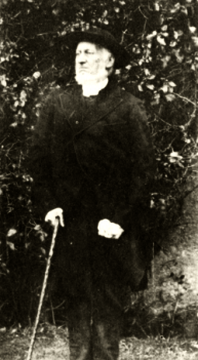
Archibald Henry Hamilton (1835-1914)
Reproduced from Hankins, T.L. (1980), Sir William Rowan Hamilton. Baltimore: The Johns Hopkins University Press.
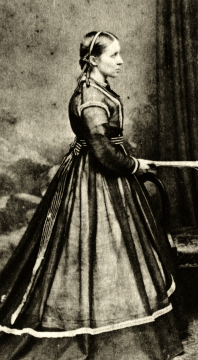
Helen Eliza Amelia O’Regan née Hamilton (1840-1870)
Reproduced from Hankins, T.L. (1980), Sir William Rowan Hamilton. Baltimore: The Johns Hopkins University Press.
Family, friends and colleagues

Sydney Margaret Hamilton (1810-1889)
Reproduced from Hankins, T.L. (1980), Sir William Rowan Hamilton. Baltimore: The Johns Hopkins University Press.

Lady Campbell, Pamela FitzGerald (1796-1869)
Reproduced from Campbell, G. (1904),
Edward and Pamela FitzGerald. London: Edward Arnold.
archive.org

Sir Guy Campbell (1786-1849)
Reproduced from the collection of the Royal Regiment of Fusiliers Museum, Royal Warwickshire.
warwickfusiliers
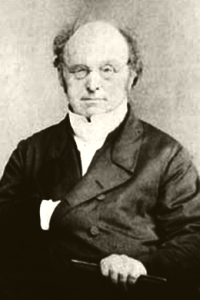
Augustus De Morgan (1806-1871)
Reproduced from math.info - History - Mathematicians.
apprendre-math.info

Aubrey Thomas de Vere (1814-1902)
Reproduced from Vere, A. de (1897),
Recollections of Aubrey de Vere. London: Edward Arnold.
archive.org

Lady Wilde, Jane Francesca Agnes Elgee, Speranza (1821-1896)
Reproduced from Sherard, R.H. (1916),
The real Oscar Wilde. London: T. Werner Laurie.
archive.org

John Thomas Graves (1806-1870)
Reproduced from Brown, E., Rice, A. (2013),
From points of inflection to bones of contention. Brown_Rice

Robert Perceval Graves (1810-1893)
Reproduced from
The Graves Family of Yorkshire and Mickleton Manor, Gloucestershire, England. gravesfa.org

Charles Graves (1812-1899)
Reproduced from Oakley, Ch.'s home page, subpage: Charles Graves.
cgoakley.org

Earl of Dunraven, Windham Henry Quin (1782-1850)
Reproduced from BBC: Your Paintings. From The National Library of Wales.
bbc.co.uk/arts

Countess of Dunraven, Caroline Wyndham (ca 1789-1870)
Reproduced from Bridgend County Borough Council, Hall of Fame.
bridgend.gov.uk

Earl of Dunraven, Lord Adare, Edwin Richard Wyndham Quin (1812-1871)
Reproduced from Wikipedia,
wikipedia.org

Maria Edgeworth (1768-1849)
Reproduced from Wikipedia: Maria Edgeworth.
wikipedia.org

Humphrey Lloyd (ca 1800-1881)
Reproduced from Trinity College Dublin, Provost & President.
tcd.ie

Peter Guthrie Tait (1831-1901)
Reproduced from The Tait Institute, Mathematical Physics at the University of Edinburgh.
tait.ac.uk

William Wordsworth (1770-1850)
Reproduced from
The Poems of William Wordsworth 1847, London: Edward Moxon.
archive.org

Mary Wordsworth née Hutchinson (1770-1859)
Reproduced from Rydal Mount & Gardens The Historic Home & Gardens of William Wordsworth.
rydalmount.co.uk

Dora Quillinan née Wordsworth (1804-1847)
Reproduced from Beal, O. (2009)
Dora Wordsworth : A Poet's Daughter. Lancashire: Mayoh Press.
bookscumbria.com

Marquess of Northampton, Spencer Joshua Alwyne Compton (1790-1851)
Reproduced from Wikipedia: Spencer Compton, 2nd Marquess of Northampton.
en.wikipedia.org

Adam Sedgwick (1785-1873)
Reproduced from BBC: Your Paintings. From the Department of Earth Sciences and Sedgwick Museum.
bbc.co.uk/arts

Clement Mansfield Ingleby (1823-1886)
Reproduced from BBC: Your Paintings. From Redbridge Museum, Ilford Central Library, London.
bbc.co.uk/arts

John Pringle Nichol (1804-1859)
Reproduced from The University of Glasgow Story, People, Biography.
universitystory.gla.ac.uk

John Frederick William Herschel (1792-1871)
Reproduced from Clerke, Agnes M. (1895)
The Herschels and modern astronomy. London: Cassel & Co
archive.org

George Biddell Airy (1801-1892)
Reproduced from The National Portrait Gallery, Photographs Collection.
npg.org.uk

Thomas Romney Robinson (1792-1882)
Reproduced from Orden pour le Mérite für Wissenschaften und Künste.
orden-pourlemerite.de

Lady Rosse, Mary Field (1813-1885)
Reproduced from Mollan, R.C. (ed.) (2015),
William Parsons, 3rd Earl of Rosse. Manchester: Manchester University Press.
books.google.com

Lord Rosse, William Parsons (1800-1867)
Reproduced from Wikimedia: William Parsons, 3rd Earl of Rosse.
upload.wikimedia.org
Miscellaneous portraits of family, friends and colleagues

Peter Guthrie Tait and his friend William John Steele (1831-1855)
“Peterhouse Group of Graduates; from a faded photograph. P.G. Tait and W.J. Steele are the first and third, reckoning from the left. Date, 1852.”
Life and scientific work of Peter Guthrie Tait.
List of Hamilton and Hutton family members without portraits
Paternal great-grandparents
Francis Hamilton and Margaret Blood
James McFerrand and Elizabeth McEwan
Maternal great-grandparents
Robert Hutton and Sarah Lewis
Philbert Guinin and Mary Webber
Paternal grandparents
William Hamilton and Grace McFerrand
Maternal grandparents
Robert Hutton and Mary Anne Guinin (“Grandmother Hutton”)
Paternal grandaunts and -uncles
Children of James McFerrand and Elizabeth McEwan
among whom:
?? McFerrand and ?? Campbell (“Grand-aunt Campbell”)
Margaret Hamilton (“Aunt Collins”) and J. Collins
Roger Hamilton
Francis Hamilton and Mary Butler
Maternal granduncles and -aunts
Children of Robert Hutton and Sarah Lewis
among whom:
Henry Hutton and Susannah Barber, Olivia Mason
Daniel Hutton and Elizabeth Edwards
Henry Thomas Guinin, died early
Bridget Lettitia Guinin
Parents
Archibald Hamilton and Sarah Hutton
Sisters
Grace, Eliza Mary, Sydney Margaret, and Archianna Priscilla Hannah Hamilton
Maternal aunts and uncles
Mary Hutton (“Aunt Mary”)
Susannah Hutton (“Aunt Susan”) and John Willey (“Uncle Willey”)
Paternal uncles and aunts
Arthur Rowan Hamilton
James Hamilton (“Uncle”) and Elizabeth Boyle (“Aunt”)
Jane Sydney Hamilton (“Aunt Sydney”)
Paternal cousins
Children of James Hamilton and Elizabeth Boyle
Maternal cousins
Children of Susanna Hutton and John Willey
Paternal cousins once removed
Son of Francis Hamilton and Mary Butler: Arthur (“Cousin Arthur”)
Sister of Cousin Arthur: Margaret Hamilton, married Gabriel Whistler
Siblings of Cousin Arthur and Margaret Hamilton: John, Mary and Ann Eleanor Hamilton














































